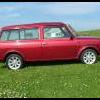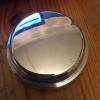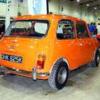
Drum And Disc Wear Lips
#1

Posted 31 October 2010 - 04:59 PM
I've been repairing/restoring cars and motorcycles for over 40 years and have frequently come up with the age old problem of removing a drum over a wear lip or drawing pads from calipers with a similar problem caused by the lip on the edge of the disc. In some extreme cases on some vehicles, some garages have had to resort to smashing a drum off when the self adjuster has seized. I know this is not such a great problem on Minis - unless the adjuster is seized solid.
Now, I'm only a time served Aeronautical Engineer and not a mechanic, but why is a brake drum wider than the swept area of the shoe? Wouldn't it make much more sense if the last few millimeters of the drum at the outer edge were bevelled at say 30 degrees? OK, the lining would eventually wear with a small lip, but at least the drum would come off.
Same situation with the disc - if it were smaller than the swept area of the pad by 1mm then the pad would end up with the lip (and that crusty/rusty edge would be constantly kept clean by the pad lip) OK I will concede that when the pads were really worn on a non-vented (thin) disc the pad lips could touch, but a fragile piece of pad material would not prevent the pads gripping. Plus point - it would also reduce unsprung weight, minus point - there would be less material, so the brake temp could increase marginally.
Anyone got any thoughts on this?
#2

Posted 31 October 2010 - 05:39 PM
#3

Posted 31 October 2010 - 05:42 PM
#4

Posted 31 October 2010 - 06:14 PM
#5

Posted 31 October 2010 - 08:27 PM
Even with regular maintenance this wear lip causes problems in the trade at relatively low mileages and WAY before the wear limit of the drum or disc has been reached. On self adjusting types where the shoe is continually being moved to almost touch the drum, you only need a few thou of an inch lip to prevent you removing the drum (ask anyone in the trade who has worked on a twin wheel Transit!!) As I said, this is not much of a problem on Minis - my question was more general than that to see if anyone could come up with a very sound engineering reason for me not modifying mine! I have a Harrison 140 Lathe in my workshop - well capable of chamfering my drums and reducing the diameter of my discs - a nice little job during the winter perhaps? Thanks bmcecosse for sharing the info about the Fiesta conversion - if its good enough for them..........
#6

Posted 31 October 2010 - 08:46 PM
Its such a simple idea that would surely have occured to to an automotive engineer at some point over the last 30 odd years. Even just from a cost saving point of view, losing a few mm of the diameter of a brake disc would mean the componant would be cheaper to make and hence more profit.
I know we have a few automotive type engineers on board here so, 998dave,mk3coopers and sukidawg if you're reading this, why hasn't this been done??
#7

Posted 31 October 2010 - 08:51 PM
Now, I'm only a time served Aeronautical Engineer and not a mechanic, but why is a brake drum wider than the swept area of the shoe? Wouldn't it make much more sense if the last few millimeters of the drum at the outer edge were bevelled at say 30 degrees? OK, the lining would eventually wear with a small lip, but at least the drum would come off.
You do know you're on about BMC right? BMC where cheap and badly managed. They got something that worked they kept it, for a LONG time. We've also got manufacturing processes and tooling along with mass production issues.
Sure, you could make the drum closer to the correct width, but there more room for error on the day Terry is off sick and the new boy has to adjust the machine.
Least that's my theory.
#8

Posted 31 October 2010 - 11:56 PM
Next time you drive anywhere near a ford.... no not a ford car, a ford as in river or stream crossing, quite a few will have the sign "now try your brakes" this is to clear the water.
#9

Posted 01 November 2010 - 06:24 AM
if the outer edge of the pads overlap the discs, when the pads in contact with the discs start to wear down the outer unworn pad lining will make contact with each other and the pistons will not be able to push the linings against the disc and you will have no braking very quickly.
because of this your pads will only last a short time, you will have no indication of brake wear eg long pedal travell, and no visual indication of worn disc as you cannot see a lip on the outer edge on the disc.
#10

Posted 01 November 2010 - 06:29 AM
#11

Posted 01 November 2010 - 04:19 PM
I also appreciate the bit about 'tolerance build up' but we're talking specific here - my car has it's own dimensions I can work to, as does yours. I said earlier that I might reduce the disc diameter to perhaps 1mm inside the pad edge and that little piece of pad would definitely not produce a temperature gradient sufficient to crack a pad.
Also the comment about wet drums was noted, but I'm talking about a chamfer - not leaving the edge of the lining waving in the air. Therefore the lining will wear to touch this chamfer but as I said it will then not prevent drum removal.
I also have to dismiss the comment about not knowing you have brake wear due to 'long pedal travel' You do not get a longer pedal travel on a disc set up anyway as the pads wear, the caliper pistons follow the wear. As for having no wear lip on the outside, that's the whole point of the exercise, but the lip will still be present on the inner edge of the disc and I would never rely on a visual wear lip to tell me the disc was worn - I would always use accurate measurement.
Strange that the guy with the Fiesta disc conversion has exactly what I'm suggesting at the front, do you have any problems BMCECOSSE?
#12

Posted 01 November 2010 - 06:09 PM
It is standard practice at our garage to remove the lip from the drum with the angle grinder (no lathe available), and after 30 years of daily practice I have got quite good at putting on a chamfer as you describe. I can only say it is an excellent idea to have a chamfer as it not only eases the removal of the drum but also allows brake dust and / or water to drop out instead of being retained by the lip. I suspect manufacturers don't do this because it is one more machining operation adding to costs, coupled with the fact that service schedules and lazy dealerships never remove the rear drums for the first 3 years after which period many owners move away from dealer servicing so they never see or are effected by the problem.
Regarding the front discs, MRA Minis is correct in that the pads can touch together in the middle if you arrange a overhang. I have only ever seen this once, and virtually all front braking effort was lost, There is no advantage in keeping the edge of the disc shiny, and the pads can easily be removed by first levering them back a little in the calipers.
#13

Posted 01 November 2010 - 07:27 PM
Anyway back to my solution, which might sound a bit tedious, after doing the drums, I intend to put a chamfer on the edge of the disc, the outer edge of this (where the pad sweeps) will be inside the swept area but the disc will be left full diameter, so it will actually come to a shallow point. This way the pads can never touch, but there will be no outer lip.
#14

Posted 01 November 2010 - 07:56 PM
#15

Posted 01 November 2010 - 08:30 PM
As many I found out the hard way as an apprentice by dressing my front discs and removing the lip. They always faded and warped very soon after.
Presumably the drums is a simular thing to retain the strength and avoid ovality?
1 user(s) are reading this topic
0 members, 1 guests, 0 anonymous users



















